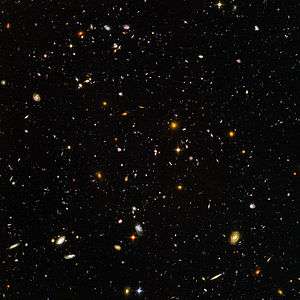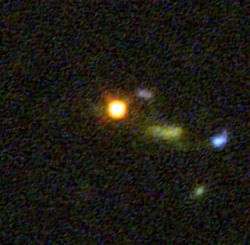UDF 2457
UDF 2457 is the Hubble Ultra Deep Field (UDF) identifier for a red dwarf star calculated to be about 59,000 light-years (18 kiloparsecs) from Earth[2] with a very dim apparent magnitude of 25.[1]
| Observation data Epoch J2000 Equinox J2000 | |
|---|---|
| Constellation | Fornax[1] |
| Right ascension | 03h 32m 38.79s[1] |
| Declination | −27° 48′ 10.0″[1] |
| Apparent magnitude (V) | 25[1] |
| Characteristics | |
| Spectral type | M dwarf[2] |
| Astrometry | |
| Distance | 59,000[2] ly |
| Details | |
| Database references | |
| SIMBAD | data |
 UDF 2457 is located above the spiral galaxy UDF 423 in the lower right quadrant of the Hubble Ultra Deep Field. | |
The Milky Way galaxy is about 100,000 light-years in diameter,[3] and the Sun is about 25,000 light-years from the galactic center.[4] The small common star UDF 2457 may be one of the farthest known stars inside the main body of the Milky Way. Globular clusters (such as Messier 54 and NGC 2419) and stellar streams are located further out in the galactic halo.
See also
- UDFj-39546284 – farthest galaxy seen by the Hubble Ultra Deep Field
References
- "UDF 2457". Wikisky. Retrieved 2010-10-28.
- Sangeeta Malhotra. "As far as the Hubble can see" (PDF). Arizona State University. Retrieved 2010-10-28.
- Christian, Eric; Safi-Harbr, Samar (1998-03-17). "How large is the Milky Way?". NASA: Ask an Astrophysicist. Retrieved 2007-11-28.
- Gillessen, S.; Eisenhauer; Trippe; Alexander; Genzel; Martins; Ott (2009). "Monitoring Stellar Orbits Around the Massive Black Hole in the Galactic Center". The Astrophysical Journal. 692 (2): 1075–1109. arXiv:0810.4674. Bibcode:2009ApJ...692.1075G. doi:10.1088/0004-637X/692/2/1075.
This article is issued from Wikipedia. The text is licensed under Creative Commons - Attribution - Sharealike. Additional terms may apply for the media files.
